陈新仁《英语语言学实用教程》章节题库(含名校考研真题)-第8~11章【圣才出品】
陈新仁《英语语言学实用教程》配套题库【章节题库(含名校考研真题)】(英语语言的应用(II))【圣才出
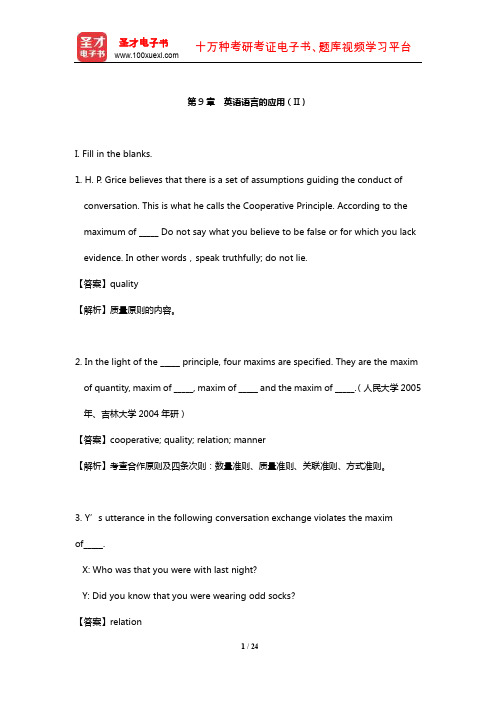
第9章英语语言的应用(II)I. Fill in the blanks.1. H. P. Grice believes that there is a set of assumptions guiding the conduct of conversation. This is what he calls the Cooperative Principle. According to the maximum of _____ Do not say what you believe to be false or for which you lack evidence. In other words,speak truthfully; do not lie.【答案】quality【解析】质量原则的内容。
2. In the light of the _____ principle, four maxims are specified. They are the maxim of quantity, maxim of _____, maxim of _____ and the maxim of _____.(人民大学2005年、吉林大学2004年研)【答案】cooperative; quality; relation; manner【解析】考查合作原则及四条次则:数量准则、质量准则、关联准则、方式准则。
3. Y’s utterance in the following conversation exchange violates the maximof_____.X: Who was that you were with last night?Y: Did you know that you were wearing odd socks?【答案】relation【解析】很显然Y的回答与X的问题“你昨晚跟谁在一起?”无关。
陈新仁《英语语言学实用教程》配套题库【章节题库(含名校考研真题)】(英语语言意义(II))【圣才出品

第7章英语语言意义(II)I. Fill in the blanks.1. Predication analysis is to break down predications into their constituents: _____, _____.【答案】argument; predicate【解析】述谓结构分析把述谓结构分析分割为论元和谓词。
其中谓词是控制论元的主要要素。
2. _____is a type of meaning-dependence between one sentence and another. In terms of truth value, the following relationships exist between the two sentences if a entails b: When a is true, b is necessarily true; when b is false, a is false; when b is true, a may be true or false.【答案】Entailment【解析】蕴含是具有独立意义的不依赖于句子所处的语境。
如果a蕴含b,那么它们存在着如下的真值关系:当a为真时,b也一定为真;当b为假时,a为假;当a为假时,b或真或假;当b为真时,a或真或假。
3. _____means two sentences may have the same meaning, that is, in terms of truth value, a has the same truth value as b: If a is true, b is true; also if a is false, b is false; and vice versa.【答案】Synonymy【解析】同义关系指两个句子拥有同样的意思,即在真值方面,a与b真值相同。
陈新仁《英语语言学实用教程》配套题库【章节题库(含名校考研真题)】(英语语言变体(I))【圣才出品】

第10章英语语言变体(I)I.Fill in the blanks.1. Any discourse can be seen as a configuration of field,mode and _____.(中山大学2003年研)【答案】tenor【解析】话语包括语场、语式、语旨三个方面。
2. More qualifiers and intensifiers are used by _____.【答案】women【解析】语言使用的性别差异。
3. Language varieties other than the standard are called nonstandard, _____ language.【答案】vernacular【解析】凡属标准语之外的那些语言变体都被叫做非标准语或本地语。
4. A linguistic _____ refers to a word or expression that is prohibited by the “polite”society from general use.【答案】taboo【解析】禁忌语是由于宗教、政治或性别原因而避免使用的词汇,通常被委婉语所代替。
5. Language itself is not sexist, but its use may reflect the _____ attitude connoted in the language that is sexist.【答案】social【解析】语言本身是不存在性别歧视的,但当语言被不同的人使用时,则会反映出社会中存在的性别歧视现象。
6. In terms of sociolinguistics, _____ is sometimes used to refer to the whole of a person’s language.【答案】idiolect【解析】从社会语言学的角度讲,个人习语指个人语言风格。
陈新仁《英语语言学实用教程》(章节题库第12章英语习得)【圣才出品】

陈新仁《英语语⾔学实⽤教程》(章节题库第12章英语习得)【圣才出品】第12章英语习得Ⅰ.Fill in the blanks.1.The type of language constructed by second or foreign language learners who are still in the process of learning a language is often referred to as_____.(中⼭⼤学2008研)【答案】interlanguage【解析】中介语是在外语或第⼆语⾔学习中形成的。
2.An influential claim regarding the input issue is the hypothesis that there must be sufficient,comprehensible input available to L2learners,as captured by the_____ formula.【答案】“i+1”【解析】关于输⼊问题,⼀个有影响⼒的说法是假设对于第⼆语⾔学习者必须有可获得的⾜够的以及能够被理解的输⼊,⽤公式可表⽰为“i+1”。
3.Error is the grammatically incorrect form;_____appears when the language is correct grammatically but improper in a communicational context.(中⼭⼤学2008研)【答案】mistake【解析】mistake是指在语法上正确但在交流语境中不恰当。
4._____are“the special thoughts or behaviors that individuals use to help them comprehend,learn,or retain new information”.【答案】Learning strategies【解析】学习策略是指特殊的想法或⾏为,这种想法或⾏为能够帮助学习者理解,学习或者获得新的信息。
陈新仁《英语语言学实用教程》(考研真题精选选择题)【圣才出品】
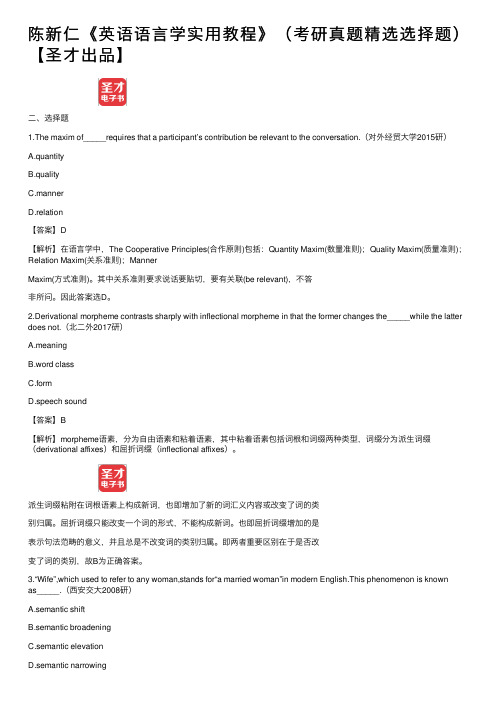
陈新仁《英语语⾔学实⽤教程》(考研真题精选选择题)【圣才出品】⼆、选择题1.The maxim of_____requires that a participant’s contribution be relevant to the conversation.(对外经贸⼤学2015研)A.quantityB.qualityC.mannerD.relation【答案】D【解析】在语⾔学中,The Cooperative Principles(合作原则)包括:Quantity Maxim(数量准则);Quality Maxim(质量准则);Relation Maxim(关系准则);MannerMaxim(⽅式准则)。
其中关系准则要求说话要贴切,要有关联(be relevant),不答⾮所问。
因此答案选D。
2.Derivational morpheme contrasts sharply with inflectional morpheme in that the former changes the_____while the latter does not.(北⼆外2017研)A.meaningB.word classC.formD.speech sound【答案】B【解析】morpheme语素,分为⾃由语素和粘着语素,其中粘着语素包括词根和词缀两种类型,词缀分为派⽣词缀(derivational affixes)和屈折词缀(inflectional affixes)。
派⽣词缀粘附在词根语素上构成新词,也即增加了新的词汇义内容或改变了词的类别归属。
屈折词缀只能改变⼀个词的形式,不能构成新词。
也即屈折词缀增加的是表⽰句法范畴的意义,并且总是不改变词的类别归属。
即两者重要区别在于是否改变了词的类别,故B为正确答案。
3.“Wife”,which used to refer to any woman,stands for“a married woman”in modern English.This phenomenon is knownas_____.(西安交⼤2008研)A.semantic shiftB.semantic broadeningC.semantic elevationD.semantic narrowing【答案】D【解析】词义缩⼩是指原来的词义缩⼩或被限制到某个明确的意义上。
陈新仁《英语语言学实用教程》(考研真题精选 判断正误)【圣才出品】
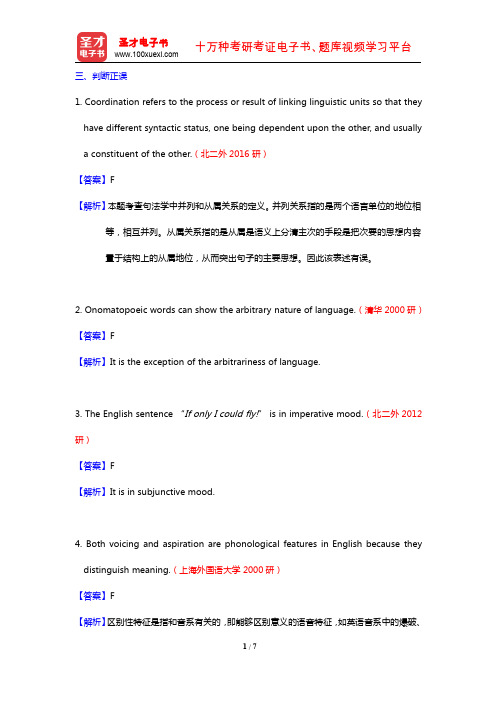
圣才电子书 十万种考研考证电子书、题库视频学习平台
双唇、清音等特征。voicing 是能够区别意义的语音特征之一,但 aspiration 不是。
5. The “Theory of Conversational Implicature” was first proposed by John L. Austin.(北二外 2015 研) 【答案】F 【解析】本题考查会话含义理论。会话含义理论是美国哲学家格莱斯首先提出的,它是语用
2. Onomatopoeic words can show the arbitrary nature of language.(清华 2000 研) 【答案】F 【解析】It is the exception of the arbitrariness of language.
3. The English sentence “If only I could fly!” is in imperative mood.(北二外 2012 研) 【答案】F 【解析】It is in subjunctive mood.
学的核心内容。而奥斯汀提出的是言语行为理论,因此该表述有误。
6. Auditory phonetics studies how sounds are perceived by the speaker.(清华 2001 研) 【答案】F 【解析】It studies how sounds are perceived by the hearer.
7. The Cooperative Principle, an important pragmatic principle proposed by P. Grice, aims to explain how we mean more than we say.(上海外国语大学 2000 研)
陈新仁《英语语言学实用教程》考研模拟试题及详解(一)【圣才出品】
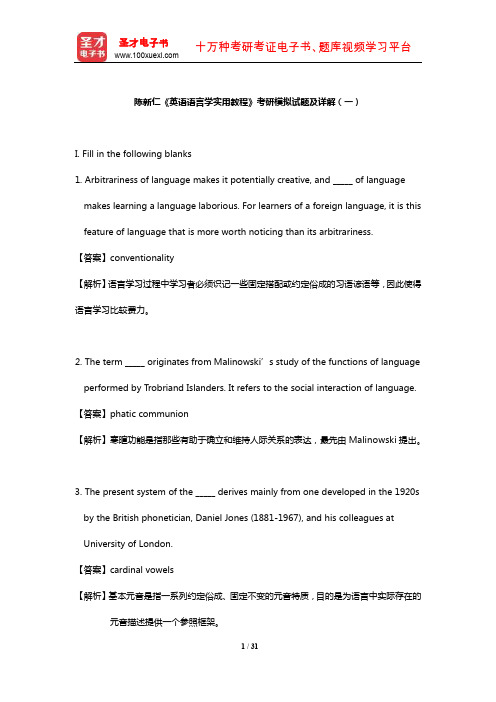
陈新仁《英语语言学实用教程》考研模拟试题及详解(一)I. Fill in the following blanks1. Arbitrariness of language makes it potentially creative, and _____ of language makes learning a language laborious. For learners of a foreign language, it is this feature of language that is more worth noticing than its arbitrariness.【答案】conventionality【解析】语言学习过程中学习者必须识记一些固定搭配或约定俗成的习语谚语等,因此使得语言学习比较费力。
2. The term _____ originates from Malinowski’s study of the functions of language performed by Trobriand Islanders. It refers to the social interaction of language. 【答案】phatic communion【解析】寒暄功能是指那些有助于确立和维持人际关系的表达,最先由Malinowski提出。
3. The present system of the _____ derives mainly from one developed in the 1920s by the British phonetician, Daniel Jones (1881-1967), and his colleagues at University of London.【答案】cardinal vowels【解析】基本元音是指一系列约定俗成、固定不变的元音特质,目的是为语言中实际存在的元音描述提供一个参照框架。
陈新仁《英语语言学实用教程》配套题库【课后练习】(英语语言单位)【圣才出品】

(2) Formulate a morphological rule regarding how to form the plural verb form from the singular verb form in Samoan.
Key: Positive terms can have negative morphemes added to them, as in “happy-unhappy”, but semantically negative ones rarely do, because unis deprecatory as well as negative.
Key: Duplicate the penultimate syllable.
2 / 24
圣才电子书 十万种考研考证电子书、题库视频学习平台
3. English has a couple of affixes that serve to express the opposition of meaning, of which un- figures prominently. Observe the following sets of English words (words marked with are not allowed in English):
Ask (1) Which other affixes are there in English that function as markers of negation?
陈新仁-英语词汇学教程课后答案-第八单元

Unit 8Check Your UnderstandingState whether each of the following statements is TRUE or FALSE.a. English words are either appreciative or derogatory. (F)b. The affective meaning of a word may change over time. (T)c. Affective meaning has nothing to do with culture. (F)d. The semantic prosody of a word determines the affective meaning of its collocates. (T)e. A variety of lexical devices are employed in English to express affective meanings. (T)In-Class Activities1. The following two pairs of sentences contain four words in bold face.A. a. His (her) eyes sparkled with amusement (merriment, good humour, high spirits, happiness).b. His (her) eyes glittered with anger (rage, hatred, malice).B. a. Look at that lovely little girl.b. Look at that tiny girl.ASK:(1) Can the two words in bold face in each pair of sentences be used interchangeably? If not,why?(2) Can you suggest more pairs like the above ones?KEY:Answer:(1) No. The verbs sparkle and glitter are close synonyms. They are different in terms of affective connotations. In the above two sentences, both adjectives (little and tiny) describe the smallness of the girl. However, little suggests ‘attractiveness’ and ‘pleasantness’ while tiny implies the abnormal growth of the child. Therefore, little is appreciative while tiny is derogatory.(2) Slim and skinnyFamous and notoriousProud and arrogantConfident and conceited2. The following are the concordance lines of the verbs cause and provide obtained with thecorpus tool from a very small part of BNC (spoken and part of written news report). Observe the collocates of the two words and answer the questions that follow.ASK:(1) What are the features of the two words in terms of semantic prosody?(2) Can you use each of the two words in a sentence of your own?Answer:(1) Cause is often used with words with a negative feature, that is, something unpleasant, such as problem, damage, danger, chaos. Provide is often used with words with a positive feature, or something useful, for example, food accommodation, necessities, comfortable conditions.(2) The bad weather is causing problems for many farmers.The hospital has a commitment to provide the best possible medical care.3. One interesting finding about semantic prosody is that it often demonstrates some relationship with transitivity. Louw (1993) points out that where human beings are in control of their own destiny and are shaping it transitively for themselves, the semantic prosody is positive, but where people are at the mercy of forces beyond their control, the things which build up intransitively are negative and uniformly threatening. For example, the verb phrase “break out”can be both transitive and intransitive (Sinclair, 1990). Observe the following concordance lines in which break out appears:(1) Which of the lines above involve the transitive use of break out? Which involve theintransitive use of break out?(2) What are the semantic features of break out in these sentences?Answer:(1) Break out in Line 1-8 is intransitive whereas it is transitive in Line 9-15.(2) Break out in Line 1-8 is used with the subject being something negative, such as war, fight, trouble, violence. However, break out in Line 9-15 is used with words expressing something that pleasant, such as beer, barbecue, apple cider.4. The following is an excerpt from Henrik Ibsen’s drama A Doll’s House. Read this excerpt and then answer questions.Mrs. Linde: But how dare a man of his education be so forward?Nora: What on earth are you talking about?Mrs. Linde: Oh, stop pretending, Nora. Do you think I haven’t guessed who it was who lent you that two hundred pounds?Nora: Are you out of your mind? How could you imagine such a thing? A friend, someone who comes here every day! Why, that’d be an impossible situation!Mrs. Linde: Then it really wasn’t him?Nora: No, of course not. I’ve never for a moment dreamed of -- anyway, he hadn’t any money tolend then. He didn’t come into that till later.Mrs. Linde: Well, I think that was a lucky thing for you, Nora dear.Nora: No, I could never have dreamed of asking Dr. Rank – Though I’m sure that if I ever did ask him—Mrs. Linde: But of course you won’t.Nora: Of course not. I can’t imagine that it should ever become necessary. But I’m perfectly sure that if I did speak to Dr. Rank—Mrs. Linde: Behind you husband’s back?Nora: I’ve got to get out this other business; and that’s been going on behind his back. I’ve got to get out of it.Mrs. Linde: Yes, well, that’s what I told you yesterday. But—Nora (walking up and down): It’s much easier for a man to arrange these things than a woman—Mrs. Linde: one’s own husband, yes.Nora: Oh, bosh, (Stops walking.) When you’ve completely repaid a debt you get your I. O. U.back, don’t you?Mrs. Linde: Yes, of course.Nora: And you can tear it into a thousand pieces and burn the filthy, beastly thing!Mrs. Linde(looks hard at her, puts down her sewing and gets up slowly): Nora, you’re hiding something from me.Nora: Can you see that?Mrs. Linde: Something has happened since yesterday morning. Nora, what is it?Nora (goes towards her): Christine! (listens.) Ssh! There’s Torvald. Would you mind going into the nursery for a few minutes? Torvald can’t bear to see sewing around. Anne-Marie’ll help you.Mrs. Linde (gathers some of her things together): Very well. But I shan’t leave this house until we’ve talked this matter out.She goes into the nursery, left. As she does so, Helmer enters from the hall.Nora (runs to meet him): Oh, Torvald dear, I’ve been so longing for you to come back! Helmer: Was that the dressmaker?Nora: No, it was Christine. She’s helping me mend my costume. I’m going to look rather splendid in that.Helmer: Yes, that was quite a bright idea of mine, wasn’t it?Nora: Wonderful! But wasn’t it nice of me to give in to you?Helmer(takes her chin in his hand): Nice—to give in to your husband? All right, little silly, I know you didn’t mean it like that. But I won’t disturb you. I expect you’ll be wanting to try it on.Nora: Are you going to work now?Helmer: Yes. (Shows her a bundle of papers.) Look at these. I’ve been down to the bank—(Turns to go into his study.)Nora: Torvald.Helmer: (stops): Yes.Nora: If a little squirrel asked you really prettily to grant her a wish—Helmer: First I should naturally have to know what it was.Nora: Squirrel would do lots of pretty tricks for you if you granted her a wish.Helmer: Out with it, then.ASK:(1) How many types of lexical devices are used to convey each of the speaker’s affect? What arethey?(2) What do you think are the effects of these lexical devices?Answer:(1) Interjections: oh, wonderful, out with itExclamatory what and how: how dareExaggerative expressions: a thousand piecesIntensifiers: so, quite, rather, much, of course, never, on earth, really, naturally, completely, perfectly(2) These lexical devices clearly shows the speaker’s affect and attitude5. In English, there are numerous expressions deployable for intensifying an attitude or emotion. Look at the following utterances.a. I did not regret a drop [a rush/a tittle].b. My father did not care a straw [a bean/a fig/a jot/a button].c. Mary did not worry a pin [a scrap].d. The man did not flinch a hair.ASK:(1) How are these expressions similar to each other?(2) Can you provide more expressions of the same kind?Answer:(1) They mean “a small amount” and they are all used with “not”, forming emphasizing negatives.(2) a bit, a touch, a hint, a trace, a grain, a speck, an ounce, an itom6. It is often necessary that public notices be written with emphatic tones. Look at the following notices.ASK:(1) Which word can be omitted without affecting the basic meaning of the notice in each case?(2) Do you know of other ways that may serve to intensify the tone of public notices?Answer:(1)anytime, strictly, absolutely(2)never, anyone, anywhere, anyway, completely, definitely, entirelyPost-Class Tasks1. In the following table, words in the first column are appreciative words. Match them with words in the right column that are derogatory.Appreciative Derogatoryself-assured over-the-topgenerous fancifulthrifty arrogantdetermined nosyshrewd self-importantconfident meanfrank cunningenthusiastic abruptinquisitive stubbornimaginative extravagantAnswer:Appreciative Derogatoryself-assured self-importantgenerous extravagantthrifty meandetermined stubbornshrewd cunningconfident arrogantfrank abruptenthusiastic over-the-topinquisitive nosyimaginative fanciful2. Poets tend to be highly affectionate people. Read the following well-known poem by Robert Burns. Discuss the lexical devices that the poet uses to convey his strong emotion. What other methods does he employ for the same purpose?A Red, Red RoseMy love is like a red, red roseThat’s newly sprung in June:My love is like the melodyThat’s sweetly played in tune.As fair art thou, my bonnie lass,So deep in love am I:And I will love thee still, my dear,Till a’ the seas gang dry.Till a’ the seas gang dry, my dear,And the rocks melt wi’ the sun:And I will love thee still, my dear,While the sands o’ life shall ru n.And fare thee weel, my only love,And fare thee weel a while!And I will come again, my love,Thou’ it were ten thousand mile.Answer:(1) Exclamation: weel; amplifier: so; exaggerative expression: ten thousand mile(2) Other devices: Repetitions, exaggerations, similes3. The following words or phrases have been claimed to have a negative (‘unpleasant’, or ‘unfavourable’) semantic prosody. For each case, investigate whether this is true.For those cases that do have a negative prosody, identify near-synonyms with a neutral or positive semantic prosody.a. be bent onb. commitc. dealingsd. happene. make off withAnswer:bent on: True. For example: bent on violence, bent on destroying, bent on self-destruction, etc.) happen: True. This word is often used with words such as “accident”, “strange things”. commit: True. This word often collocates with crime, offence, rape, assault, unlawful act.Neutral synonyms: do, perform, carry outmake off with: True.dealings: Not true. This word does not necessarily collocate with negative words. Instead, neutral collocates are often found, such as dealings with customers, exchange dealings, dealings in commodities, dealings between parties, dealings in contract, dealings with business investors, dealings with corporate investors.4.Find out the emphasizing negatives in the following sentences.a. Don’t worry. I am not at all hungry.b. Sorry, but I am not the slightest bit interested in this project.c. There are none at all in this box, as far as I can see.d. I did n’t enjoy it in the least.e. There is no money whatsoever available for school trips at the moment.f. You have no excuse whatever.g. I’ll never, never go to there again.5. Read the following sentences and group them according to the type of lexical devices used to express the speaker’s affect.a. I just don’t like it.b. I kind of like him.c. You are absolutely correct.d. They literally tore his arguments to pieces.e. I so wanted to see her.f. They honestly admire her courage.g. I can well understand your feelings.h. I quite enjoyed the party, but I’ve been to better ones.i. The incident somewhat influenced his later life.Answer:Emphasiers:I just don’t like it.They literally tore his arguments to pieces.They honestly admire her courage.Amplifiers:You are absolutely correct.I so wanted to see her.I can well understand your feelings.Downtoners:I kind of like him.I quite enjoyed the party, but I’ve been to better ones.The incident somewhat influenced his later life.6. Read the following sentences and decide whether the italicized words are emphasiers, amplifiers or downtoners.a. My brother can actually speak six foreign languages. (emphasizer)b. It was a sacrifice indeed. (emphasizer)c. I can perfectly see why you are anxious about it. (amplifiers)d. I simply don’t believe it. (emphasizer)e. I know these animals slightly. (downtoners)f. I entirely agree with you. (amplifiers)g. I am sort of fond of the new teacher. (downtoners)h. That’s a somewhat thicker book. (downtoners)。
陈新仁《英语语言学实用教程》考研模拟试题及详解(二)【圣才出品】
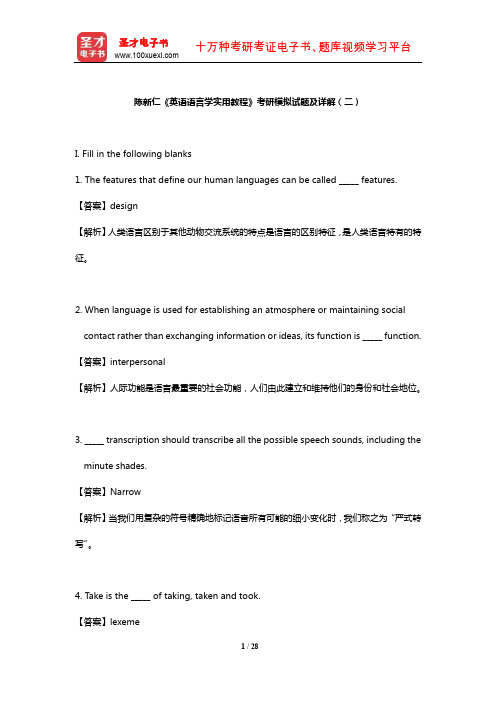
陈新仁《英语语言学实用教程》考研模拟试题及详解(二)I. Fill in the following blanks1. The features that define our human languages can be called _____ features.【答案】design【解析】人类语言区别于其他动物交流系统的特点是语言的区别特征,是人类语言特有的特征。
2. When language is used for establishing an atmosphere or maintaining social contact rather than exchanging information or ideas, its function is _____ function. 【答案】interpersonal【解析】人际功能是语言最重要的社会功能,人们由此建立和维持他们的身份和社会地位。
3. _____ transcription should transcribe all the possible speech sounds, including the minute shades.【答案】Narrow【解析】当我们用复杂的符号精确地标记语音所有可能的细小变化时,我们称之为“严式转写”。
4. Take is the _____ of taking, taken and took.【答案】lexeme【解析】词位是语言词汇的基本单位,taking, taken 和took都是take这个词位的词位变体。
5. An _____ is pronounced letter by letter, while an _____ is pronounced as a word. 【答案】initialism; acronym【解析】首字母缩写和缩略词的区别在于,前者是一个一个字母读,后者是按单词读。
陈新仁《英语语言学实用教程》配套题库【课后练习】(英语语言的应用(II))【圣才出品】
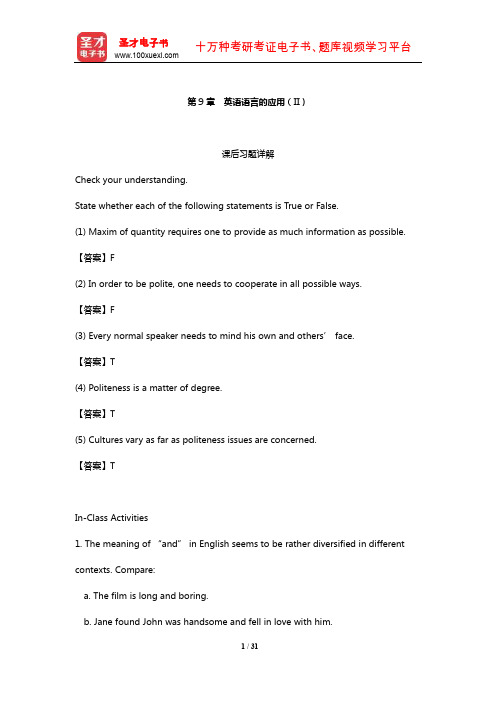
第9章英语语言的应用(II)课后习题详解Check your understanding.State whether each of the following statements is True or False.(1) Maxim of quantity requires one to provide as much information as possible. 【答案】F(2) In order to be polite, one needs to cooperate in all possible ways.【答案】F(3) Every normal speaker needs to mind his own and others’ face.【答案】T(4) Politeness is a matter of degree.【答案】T(5) Cultures vary as far as politeness issues are concerned.【答案】TIn-Class Activities1. The meaning of “and” in English seems to be rather diversified in different contexts. Compare:a. The film is long and boring.b. Jane found John was handsome and fell in love with him.c. Jane called John and told him the news.Ask(1) How would you interpret “and” in each of the cases?Key: In a, “and” is a pure conjunction that coordinates two parts. In b, “and”signals cause-effect relation. In c, “and” indicates the sequence of events, meaning “and then”.(2) Do you vote for the argument that “and” is polysemous, or the argument that“and” has just one basic meaning and the other “meanings” areimplicatures derived from the context?Now, focus on the use of “or” in English:d. His birthday is in June or July.e. For the new post, a diploma in mathematics or computer science is a must.Key: “and” has one basic meaning. Other interpretations are derived from this basic meaning plus contextual information by way of implicature.(3) It seems that “or” has two conflicting meanings. What are they? Do you thinkone meaning is basic and the other is derivable in context by virtue ofimplicature?Key: They are exclusive “or” and inclusive “or”. The inclusive “or” is more basic. The exclusive “or” is realized by way of implicature.2. Being underinformative or overinformative in daily conversation is not rare. When either happens, some implicature is intended. Look at the followingfragment of talk:Jane: What’s your stepmother like?John: She’s a woman and she married my father.Ask(1) What does John want to say in actuality?Key: The stepmother is no good.(2) Why does John answer that way, you suppose?Now consider the following:Jane: When did you come back last night?John: Two o’clock in the morning. The meeting was just too long.Key: He does not want to say directly that his stepmother is bad.(3) What does John imply in the second part of his reply?Key: He did not mean to be late.(4) Why does John give that additional information?Public signs and ads also employ additional information sometimes. Look at the following pictures:Key: He wants to explain why he was late so that Jane would pardon him, if she minded.(5) What is the extra information in each of the cases?Key: In the first picture, the additional information is that “there is ice falling”.In the second picture, the additional information is “Heart disease is the#1 killer of African Americans”. In the third picture, the additionalinformation is “水是生命的源泉。
陈新仁《英语语言学实用教程》(第2版)配套题库-章节题库-第1~3章【圣才出品】

第二部分章节题库第1章导言Ⅰ. Fill in the following blanks:1. Arbitrariness of language makes it potentially creative, and _____ of language makes learning a language laborious. For learners of a foreign language, it is this feature of language that is more worth noticing than its arbitrariness.(大连外国语学院2008研)【答案】conventionality【解析】语言学习过程中学习者必须识记一些固定搭配或约定俗成的习语谚语等,因此使得语言学习比较费力。
2. In Saussure’s view, the relationship between signifier(sound image) and signified (concept) is _____.(北二外2005研)【答案】arbitrary【解析】索绪尔认为符号的形式或声音与其意义之间没有逻辑联系,所以两者之间的关系是任意的。
3. The term _____ originates from Malinowski’s study of the functions of language performed by Trobriand Islanders. It refers to the social interaction of language.(中山大学2006研)【答案】phatic communion【解析】寒暄功能是指那些有助于确立和维持人际关系的表达,最先由Malinowski提出。
4. The features that define our human languages can be called _____ features.(北二外2006研)【答案】design【解析】人类语言区别于其他动物交流系统的特点是语言的区别特征,是人类语言特有的特征。
- 1、下载文档前请自行甄别文档内容的完整性,平台不提供额外的编辑、内容补充、找答案等附加服务。
- 2、"仅部分预览"的文档,不可在线预览部分如存在完整性等问题,可反馈申请退款(可完整预览的文档不适用该条件!)。
- 3、如文档侵犯您的权益,请联系客服反馈,我们会尽快为您处理(人工客服工作时间:9:00-18:30)。
第8章英语语言的应用(I)
I. Fill in the blanks.
1. A perlocutionary act is the act performed by or resulting from saying something; it is the _____ of, or the _____the utterance. (人大2004研)
【答案】consequence, change brought about by
【解析】言外行为指说话的效果。
2. When a teacher says “The exam this year is going to be really difficult”, the sentence would have an _____force. (清华2001研,清华2000研)
【答案】illocutionary
【解析】言外行为,表达说话人的意图。
3. _____ were sentences that did not state a fact or describe a state, and were not verifiable.
【答案】Performatives
【解析】施为句是用来做事的,既不陈述事实,也不描述情况,且不能验证其真假。
II. Multiple Choices.
1. The speech act theory was developed by _____.(对外经贸2006研)
A. John Searle
B. John Austin
C. Levinson
D. G. Leech
【答案】B
【解析】言语行为理论是哲学家约翰·奥斯丁在他《如何以言行事》一文中提出的。
它从哲学意义上对语言交际的本质进行解释,其目的在于回答”用语言干什么”这个问题。
2. Point out which item does not fall under the same category as the rest. (Focus on the type of illocutionary act) (南京大学2007研)
A. threaten
B. advise
C. beseech
D. urge
【答案】A
【解析】A为命令性言语行为,而其他三项为指示性言语行为。
3. _____ is using a sentence to perform a function. (西安外国语学院2006研)
A. A perlocutionary act
B. An illocutionary act
C. A locutionary act
D. Speech act
【答案】D
【解析】约翰·奥斯丁在他《如何以言行事》一文中提出言语行为理论, 此理论对语言交际的
本质进行解释,即指出言语行为是指用一句话来发挥作用去完成某些事情。
4. By saying “You have left the door wide open,” a speaker might be performing the three acts: locutionary, illocutionary and perlocutionary _____. (西安交大2008研)
A. at the same time
B. one after another
C. two first and then the other
D. one first and then the other two
【答案】D
【解析】言语行为理论中的发话行为先发生,然后行事行为和取效行为才发生。
行事行为和取效行为属于话后行为。
5. Which of the following statement concerning context is NOT correct?
A. It was first noted by the British linguist John Firth.
B. It is generally considered as constituted by the knowledge shared by the speaker and the hearer.
C. It determines the speaker’s use of language and also the hearer’s interpretation of what is said to him.
D. It is essential to the syntactic study of language.
【答案】D
【解析】语境这个概念由英国语言学家John Firth最先提出,一般认为它是由言者和听者
的共享知识构成,它决定着言者对语言的运用和听者对他所听到话语的理解,它对
语言的语用研究(而非句法研究)来说是必不可少的。
语言的句法研究与语境无关。
因此,本题的正确答案为D。
6. Which of the following is NOT correct?
A. The meaning of a sentence is abstract and decontextualized.
B. The meaning of an utterance is concrete and context-dependent.
C. The meaning of a sentence is based on utterance meaning.
D. Utterance meaning is the realization of the abstract meaning of a sentence in a
real situation of communication or simply in a context.
【答案】C
【解析】句子的意思是抽象的、非语境化的,而话语的意义却是具体的、依赖于语境的。
话语的意义是基于句子意义之上的;它是一个句子的抽象意义在一个真实的交际场合
或仅在一个语境中的体现。
因此,本题的正确答案为C。
7. “You have left the window wide open.”Which of the following is the illocutionary act performed by the speaker?
A. The speaker intends to ask someone to close the window or make a complaint.
B. The hearer closes the window.
C. The speaker intends to express what the words literally mean.
D. None of the above.
【答案】A
【解析】言内行为指说话这一行为的本身,使用音位、词汇、句法来表达字面意义的行为;
言外行为指表达说话者交流目的或意图的行为;而言后行为指通过某些话实施的行
为,或讲某些话所导致的行为,实际上是话语所产生的后果或者所引起的变化。
因
此,本题的正确答案为A。
8. How many categories do speech acts fall into according to John Searle?
A. Three.
B. Four
C. Five
D. Six
【答案】C
【解析】Searle区分的五类分别是:representatives(阐述类),directives(指令类),commissives(承诺类),expressives(表达类),declarations(宣告类)。
因此,本题的正确答案为C。
9. Which of the following is the typical case of commissives?
A. Believing.
B. Ordering.
C. Promising.
D. Congratulating.
【答案】C
【解析】承诺类是那些言者对未来行为过程做出承诺的言外行为,即在说话的时候,言者将
自己置于某种义务中;允诺(promising),保证(undertaking),发誓(vowing)
都是最典型的例子。
只有C符合题意。
因此,本题的正确答案为C。
10. Which of the following is the specific instance of directives?
A. Swearing.
B. Suggesting.
C. Undertaking.
D. Apologizing.
【答案】B
【解析】指令类是言者让听者做某事的企图。
邀请inviting,建议suggesting,要求requesting,忠告advising,警告warning,威胁threatening,命令ordering
都是其例。
只有B符合题意。
因此,本题的正确答案为B。
11. The Illocutionary Act was developed by _____.(西安交大2008研)
A. John Austin
B. Levinson
C. John Lyons
D. John Searle
【答案】D
【解析】美国的哲学语言学家约翰·舍尔对言语行为理论的发展做出了巨大的贡献,尤其是他对行事行为的分类。
